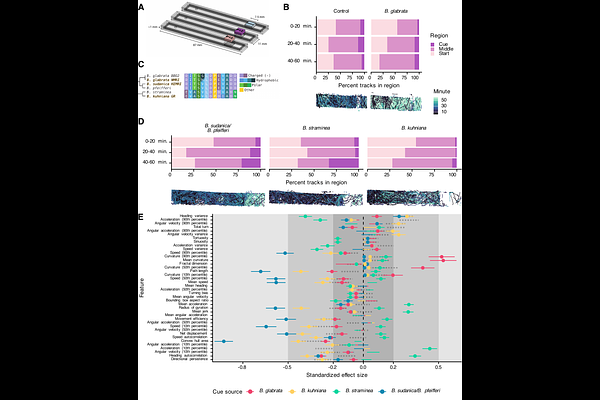Quantitative ethology of schistosome miracidia characterizes a conserved snail peptide that inhibits penetration

Quantitative ethology of schistosome miracidia characterizes a conserved snail peptide that inhibits penetration
Horejsi, R. V.; Nelson, C. N.; De Ruyter, A.; Gensch, H.; Maasz-Seawright, S.; Weber, C.; Willett, S.; Olson, S. A.; Wheeler, N. J.
AbstractOver 700 million people are at risk of contracting schistosomiasis due to regular exposure to freshwater sources where infected snails, the obligate intermediate hosts of schistosomes, are endemic. Although mass drug administration of praziquantel effectively controls the disease in most regions, achieving elimination will require reducing populations of infected snails that shed the human-infective larval stage. Considerable effort has focused on parasite development and immunological responses after snail penetration, but comparatively little is known about the molecular and behavioral host seeking events that precede it, primarily due to technical and physical constraints. To address this gap, we developed a custom imaging and computational system for tracking and screening schistosome miracidia, the snail-infective larval form that hatches from eggs. Our system employs an array of cameras without magnification and acrylic devices that maintain miracidia within the focal plane, create a field of view over 200,000 times the area of a single miracidium, and support the formation of stable chemical gradients. Using this platform, we perform quantitative ethology of miracidia at an unprecedented scale and extract features that drive the emergent chemoklinokinetic behavior in response to snail cues. We demonstrate that miracidia accumulate at the edge of a gradient of snail cues by increasing key chemoklinokinetic features upon leaving the region of a cue, corroborating previous reports. In contrast, miracidia do not exhibit these behaviors when the cue is uniform, demonstrating that they represent a specific sensory response rather than generic neuromuscular activity. We further find that a previously identified stimulatory snail peptide only partially recapitulates the full chemoklinokinetic profile, and homologues from closely related species elicit divergent behavioral outcomes. Notably, some of these snail peptides can mask a natural gradient and inhibit miracidia penetration of snails. This work establishes a scalable behavioral platform for probing parasite-snail interactions and identifies a peptide scaffold that potently blocks snail penetration.